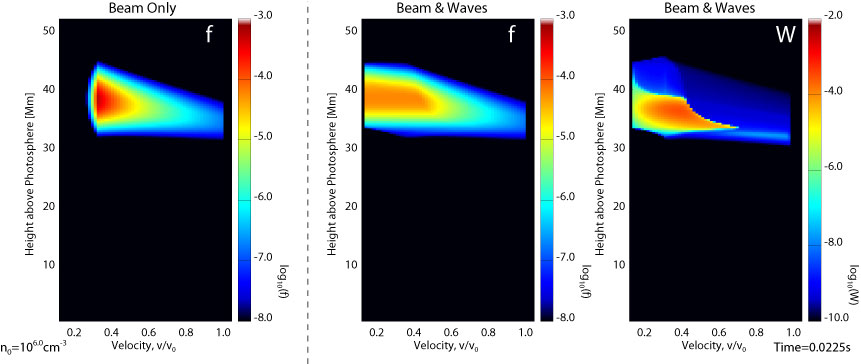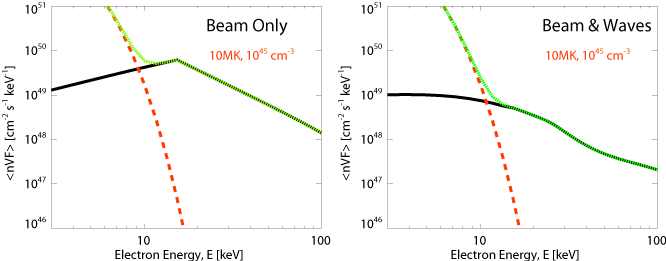Dips and Waves
From RHESSI Wiki
| Line 7: | Line 7: | ||
In the standard interpretation of RHESSI's hard x-ray emission, a powerlaw of acceelerated electrons above a sharp low energy cutoff leave the corona travelling down to the chromosphere. As they propagate they lose energy to the background plasma through Coloumb collisions, eventually losing their energy in the dense chromosphere, where they emit hard X-rays as observed by RHESSI, heating the local plasma which expands back upwards. | In the standard interpretation of RHESSI's hard x-ray emission, a powerlaw of acceelerated electrons above a sharp low energy cutoff leave the corona travelling down to the chromosphere. As they propagate they lose energy to the background plasma through Coloumb collisions, eventually losing their energy in the dense chromosphere, where they emit hard X-rays as observed by RHESSI, heating the local plasma which expands back upwards. | ||
| - | [[Image:fig3b.png]] | + | [[Image:Fwc_10009.jpg|frame|center|'''Figure 1:''' The electron distribution f and energy density of the waves W showing the simulation results from the 2 different simulations: Coulomb collisions only on the left, including wave-particle interactions on the right.) A movie of this can be found [http://www.youtube.com/watch?v=uO2U7WeHu1Q here]]] |
| + | |||
| + | [[Image:fig3b.png|frame|center|'''Figure 2:''' The mean electron flux spectrum <nVF> for the simulation with Coulomb collisions actng on the beam only (left) and the inclusion of wave-particle interaction (right). The black line shows the simulation result, the orange dashed line an overplotted thermal model spectrum. The total spectrum is the dashed green line, indicating the presence of a dip in the Coulomb collision only case.]] | ||
| + | |||
| - | |||
== Conclusions == | == Conclusions == | ||
Revision as of 14:55, 19 November 2009
Introduction
There has been some heated discussion (for instance [1]) as to whether the "dip" seen in the mean electron spectrum derived from RHESSI flare observations is a real feature as it can often be removed be correcting for albedo. But for flares with relatively low thermal mission the standard "thick-target" interpretation says that the "dip" must be there. This model only accounts for Coulomb collisions between the propagating beam of accelerated electrons and the background plasma. In this nugget we present simulation results from our recent paper [2] where we show what happens to the dip when you also include wave-particle interactions between the beam and background plasma.
Wave-particle Interactions
In the standard interpretation of RHESSI's hard x-ray emission, a powerlaw of acceelerated electrons above a sharp low energy cutoff leave the corona travelling down to the chromosphere. As they propagate they lose energy to the background plasma through Coloumb collisions, eventually losing their energy in the dense chromosphere, where they emit hard X-rays as observed by RHESSI, heating the local plasma which expands back upwards.


Conclusions
The work shown here is a step towards a more complete treatment of electron transport in solar flares and highlights that the inclusion of wave-particle interactions flattens sharp low energy cutoffs in the inital accelerated electron distribution.